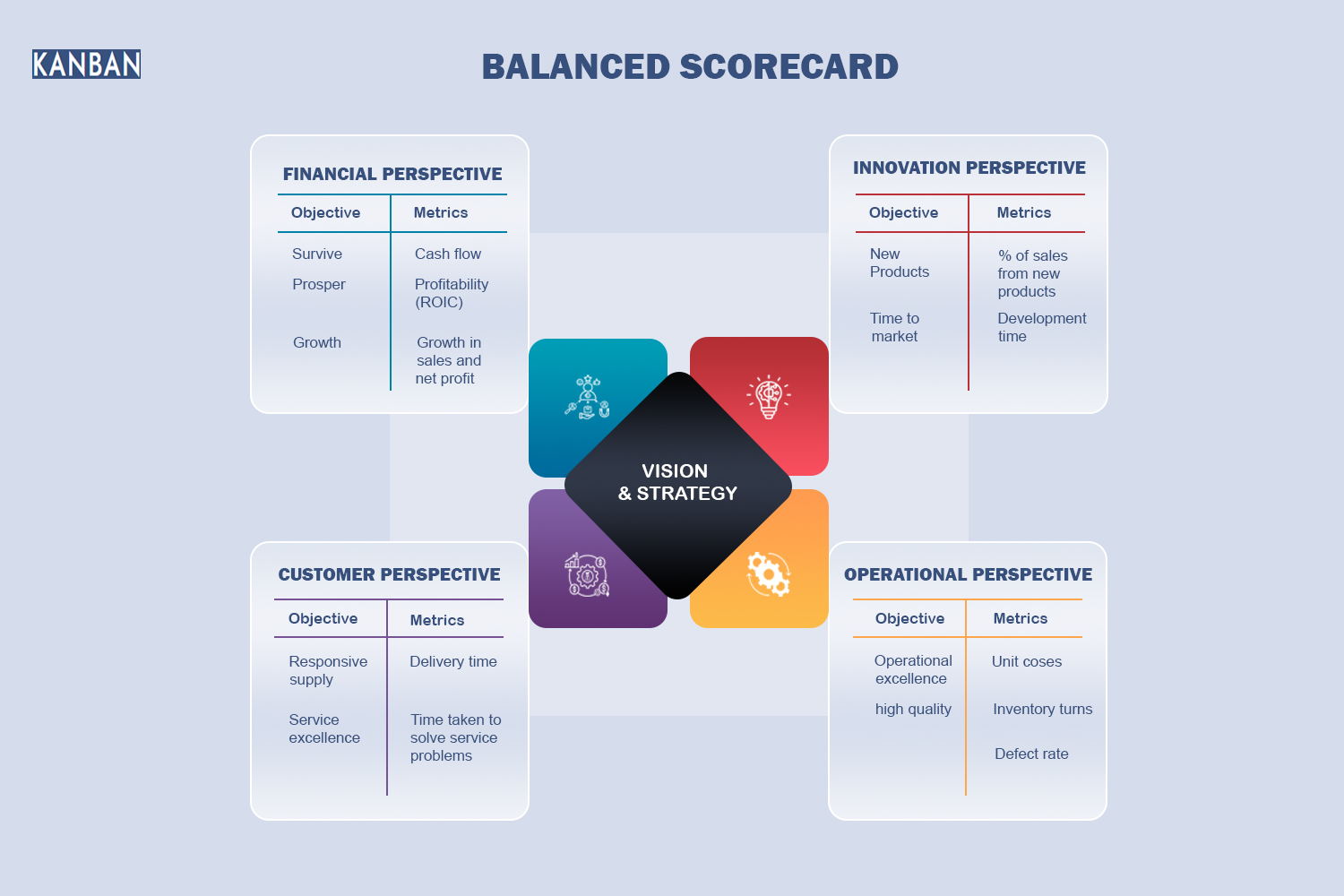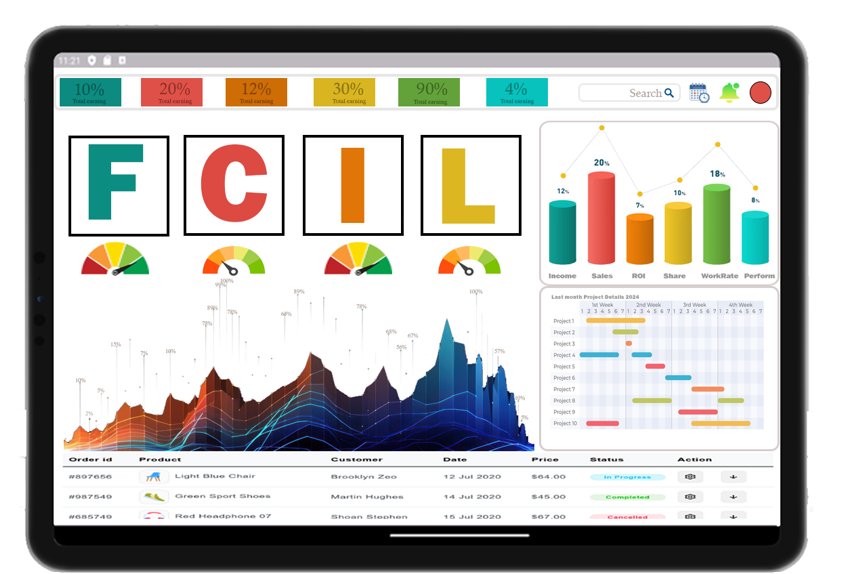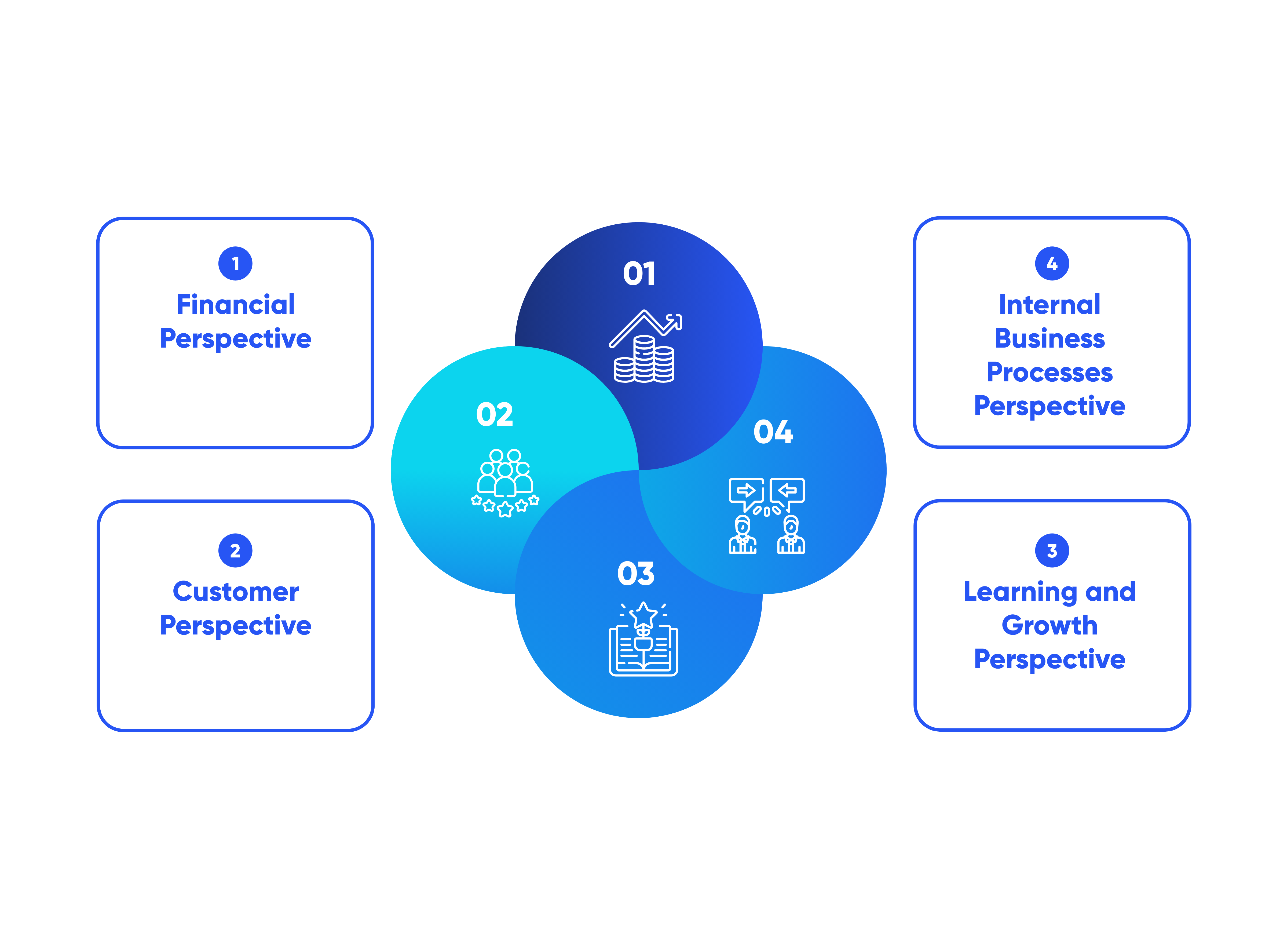The Balanced Scorecard (BSC) is a strategic management tool that helps organizations track and manage their performance by focusing on key metrics. Introduced in the 1990s, this framework offers a more comprehensive view of organizational performance by balancing financial measures with non-financial ones like customer satisfaction, internal processes, and learning and growth.
Balanced Scorecard software plays a pivotal role in operationalizing the BSC methodology by automating data collection, performance monitoring, and reporting. This allows organizations to seamlessly track progress towards their strategic goals.

The Basics of Balanced Scorecard Software
Balanced scorecard software is designed to automate the process of managing performance using the four perspectives of the BSC:
- Financial Perspective: This includes key financial metrics that indicate how well a company is generating profits and managing costs.
- Customer Perspective: This focuses on customer satisfaction, retention, and the organization's ability to attract new customers.
- Internal Processes Perspective: This perspective looks at operational efficiency, product quality, and the effectiveness of processes.
- Learning and Growth Perspective: This focuses on employee training, innovation, and corporate culture.
Using balanced scorecard software, organizations can integrate these four areas into their strategic planning and execution process. By automating data collection and reporting, the software enhances visibility and provides a clear picture of an organization’s performance across various dimensions.
Key Features of Balanced Scorecard Software
Balanced scorecard software varies by platform, but several features are essential for any system to effectively support the BSC methodology:
KPI Management
Balanced scorecard software provides tools for setting, tracking, and analyzing key performance indicators (KPIs) aligned with the organization's strategic goals. KPIs are assigned to each perspective of the balanced scorecard, and the software ensures that these metrics are measurable, actionable, and directly related to business objectives.
Data Integration
One of the key advantages of using balanced scorecard software is the ability to integrate data from multiple sources. These platforms can automatically pull data from various business systems such as enterprise resource planning (ERP), customer relationship management (CRM), and human resource management (HRM) platforms, offering real-time insights into performance across all departments.
Performance Dashboards
Balanced scorecard software provides real-time dashboards that visualize performance data for each perspective of the BSC. These dashboards are often customizable, enabling managers to view the specific KPIs that are most relevant to their responsibilities. Dashboards can include charts, graphs, and color-coded indicators that make it easy to track progress, spot trends, and identify areas that need improvement.
Strategic Mapping
Strategic maps are essential tools in the BSC framework. They visually represent the cause-and-effect relationships between different objectives across the four perspectives. Balanced scorecard software often includes strategic mapping features that allow organizations to create and visualize these relationships, helping stakeholders understand how different KPIs influence one another.
Collaboration Tools
Since the BSC framework involves multiple teams and departments, collaboration is critical. Many balanced scorecard platforms offer built-in collaboration tools, such as shared workspaces, comment features, and task assignment capabilities. These tools promote transparency and ensure that everyone is aligned with the company’s strategic objectives.
Automated Reporting
Generating reports manually can be time-consuming and error-prone. Balanced scorecard software automates this process, allowing users to generate detailed reports on performance at the click of a button. Reports can be customized to focus on specific perspectives, departments, or timeframes, and are often presented in formats that are easy to share with stakeholders.
Forecasting and Scenario Planning
Advanced balanced scorecard software includes predictive analytics features, allowing businesses to forecast future performance based on current data trends. Scenario planning tools help organizations simulate various business situations, enabling decision-makers to assess the potential impact of strategic changes before implementing them.

Benefits of Using Balanced Scorecard Software
Improved Strategic Alignment
Balanced scorecard software ensures that all levels of the organization are aligned with the overarching strategic goals. By translating high-level strategies into actionable KPIs and assigning these metrics to individual teams or departments, the software ensures that every part of the organization is working towards the same objectives. This alignment drives consistency in decision-making and fosters a shared sense of purpose.
Enhanced Decision-Making
With real-time access to performance data across all perspectives, leaders can make more informed decisions. Balanced scorecard software provides a comprehensive view of the organization’s health, allowing decision-makers to identify performance gaps, understand their root causes, and take corrective action quickly. The inclusion of forecasting tools also allows leaders to make proactive, data-driven decisions that can anticipate future challenges and opportunities.
Increased Efficiency
The automation features of balanced scorecard software eliminate the need for manual data collection and reporting. This saves time and reduces the risk of human error, allowing teams to focus on more strategic activities. Automated workflows, alerts, and notifications also ensure that everyone is kept informed about performance issues and corrective actions in real-time, reducing delays in response.
Better Performance Management
Balanced scorecard software helps organizations improve overall performance by providing transparency into the factors that drive success. By tracking KPIs and visualizing performance trends, companies can quickly identify underperforming areas and implement targeted improvement strategies. This continuous performance monitoring helps companies stay agile and responsive in a competitive business environment.
Employee Engagement
One often overlooked benefit of balanced scorecard software is its ability to increase employee engagement. By clearly communicating strategic objectives and linking them to day-to-day activities, the software helps employees understand how their work contributes to the overall success of the organization. Many platforms also include recognition features that allow managers to celebrate employee achievements, boosting morale and motivation.
How to Implement Balanced Scorecard Software Effectively
While balanced scorecard software offers numerous benefits, successful implementation requires careful planning. Here are a few best practices for getting the most out of your system:
- Define Clear Objectives: Before implementing the software, ensure that you have a clear understanding of your organization’s strategic objectives and the KPIs that will be used to measure success.
- Involve Key Stakeholders: Engage stakeholders from different departments in the implementation process to ensure that the software meets the needs of all users and supports cross-functional collaboration.
- Invest in Training: Proper training is essential to ensure that employees know how to use the software effectively. Provide ongoing training opportunities to ensure that everyone is comfortable with the platform’s features.
- Monitor and Adjust: The business environment is constantly changing, and so should your use of the balanced scorecard. Regularly review and adjust your KPIs, objectives, and strategies to ensure that the software remains aligned with your evolving goals.
Balanced scorecard Software
1. What is Balanced Scorecard software?
Balanced Scorecard software is a strategic management tool designed to help organizations automate the Balanced Scorecard (BSC) methodology. It allows businesses to monitor and manage performance metrics across financial, customer, internal processes, and learning and growth perspectives.

2. How does Balanced Scorecard software help in strategic management?
Balanced Scorecard software helps organizations align their strategic goals with daily operations. It translates high-level objectives into measurable key performance indicators (KPIs) and tracks performance across different business units to ensure strategic alignment.
3. What are the four perspectives of the Balanced Scorecard?
The four perspectives are: Financial, Customer, Internal Processes, and Learning and Growth. These perspectives help organizations evaluate performance from multiple angles, ensuring a balanced approach to success.
4. What are the key features of Balanced Scorecard software?
Key features include KPI management, data integration, real-time performance dashboards, strategic mapping, collaboration tools, automated reporting, and forecasting or scenario planning.
5. Can Balanced Scorecard software integrate with other systems?
Yes, it can integrate with systems such as ERP, CRM, and HRM, allowing data to flow seamlessly from multiple business platforms into the software for better performance monitoring and decision-making.
6. How can Balanced Scorecard software improve decision-making?
By providing real-time access to key performance data, Balanced Scorecard software enables leaders to make informed, data-driven decisions. Predictive analytics and scenario planning tools further enhance decision-making capabilities.
7. Who typically uses Balanced Scorecard software in an organization?
Top management, strategy teams, department heads, and employees involved in performance tracking typically use Balanced Scorecard software. It can be utilized across multiple departments for improved collaboration and alignment.
8. How does the software help align employees with strategic goals?
The software links strategic objectives to actionable KPIs for individual departments and teams, ensuring that everyone understands how their work contributes to overall organizational goals. This improves alignment and accountability.
9. How does Balanced Scorecard software handle reporting?
Balanced Scorecard software automates the reporting process by generating detailed performance reports across the four perspectives. These reports can be customized and shared easily with stakeholders to provide insights into organizational health.
10. Can Balanced Scorecard software support multiple users and teams?
Yes, the software supports multiple users and teams through collaboration tools, allowing different departments to work together on shared goals while tracking performance in real-time.
11. What are the benefits of using Balanced Scorecard software over manual tracking?
The software automates data collection, reporting, and monitoring, reducing human error and saving time. It provides real-time insights and a comprehensive view of organizational performance, making it far more efficient than manual tracking.
12. How do performance dashboards work in Balanced Scorecard software?
Performance dashboards visually present real-time data through charts, graphs, and indicators, allowing users to track KPIs and performance trends at a glance. Dashboards are often customizable to highlight relevant metrics for specific teams.
13. Can the software help in risk management?
Yes, Balanced Scorecard software often includes scenario planning and forecasting tools, helping organizations simulate different outcomes and assess potential risks before they arise.
14. How is strategic mapping used in Balanced Scorecard software?
Strategic mapping visually links different business objectives and KPIs, showing how various goals influence each other. It provides a clear roadmap for strategy execution and helps track progress toward achieving overarching business goals.
15. How long does it take to implement Balanced Scorecard software?
Implementation timelines vary depending on the organization's size and complexity, but it generally takes a few weeks to a few months. Effective planning, stakeholder involvement, and employee training can ensure a smoother implementation process.